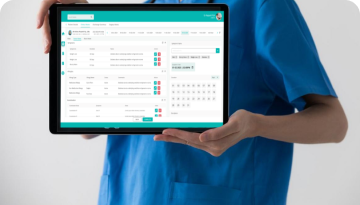
In today’s rapidly evolving healthcare landscape, efficient data management and seamless communication are crucial for success. Cloud-based integrated Hospital Information Management Systems (HIMS) offer a powerful solution, streamlining operations, enhancing patient care, and driving positive outcomes for healthcare providers and patients alike.
This comprehensive guide explores the compelling reasons why you should consider implementing a cloud-based integrated HIMS.
Enhanced Efficiency and Streamlined Operations
- Centralized Data Management: Eliminate data silos and ensure complete, up-to-date patient records accessible across departments. This reduces redundant data entry, improves accuracy, and facilitates informed decision-making.
- Automated Workflows: Automate repetitive tasks like appointment scheduling, billing, and reporting, freeing up staff time for patient care and strategic initiatives.
- Improved Communication and Collaboration: Foster seamless communication and collaboration between healthcare professionals within and across departments, leading to better coordinated care and faster response times.
- Real-Time Visibility: Gain real-time insights into hospital operations, resource utilization, and patient flow, enabling proactive management and data-driven decision-making.
Elevated Patient Care and Experience
- Improved Accessibility: Patients can access their medical records, appointments, and billing information anytime, anywhere through a secure patient portal, empowering them to actively participate in their care.
- Enhanced Communication: Secure messaging features within the HIMS facilitate communication between patients and healthcare providers, improving patient engagement and satisfaction.
- Telehealth Integration: Integrate telehealth solutions with the HIMS to offer remote consultations, medication management, and follow-up care, increasing accessibility and convenience for patients.
- Personalized Care: Leverage patient data analytics to personalize care plans, predict potential health risks, and provide preventive interventions, optimizing patient outcomes.
Cost-Effectiveness and Scalability
- Reduced IT Infrastructure Costs: Eliminate the need for expensive on-premise hardware and software investments, reducing upfront costs and ongoing maintenance expenses.
- Subscription-Based Model: Pay-as-you-go subscription models offer flexibility and affordability, scaling up or down resources as needed.
- Automatic Updates and Upgrades: Benefit from automatic system updates and security patches without manual intervention, ensuring you always have the latest features and security protocols.
- Disaster Recovery and Business Continuity: Cloud providers offer robust disaster recovery solutions, ensuring data security and system uptime even in unforeseen circumstances.
Security and Compliance
- Advanced Security Features: Cloud providers implement stringent security measures, including encryption, access controls, and intrusion detection, protecting sensitive patient data from unauthorized access.
- Compliance with Regulations: Cloud-based HIMS solutions are designed to comply with industry regulations like HIPAA and GDPR, ensuring data privacy and security.
- Regular Audits and Certifications: Many cloud providers undergo regular audits and certifications by independent bodies, providing peace of mind regarding data security practices.
Additional Benefits
- Flexibility and Mobility: Access the HIMS from any device with an internet connection, enabling remote work and improved work-life balance for healthcare professionals.
- Integration with Third-Party Applications: Integrate with other healthcare applications and devices to create a comprehensive ecosystem for managing patient care.
- Data Analytics and Reporting: Generate insightful reports and dashboards to track performance, identify trends, and make data-driven decisions.
Addressing Concerns and Overcoming Challenges
While cloud-based HIMS solutions offer numerous benefits, it’s crucial to address potential concerns and challenges:
- Data Security: Conduct thorough due diligence to ensure the cloud provider adheres to robust security protocols and data privacy regulations.
- Vendor Lock-In: Choose a vendor with a proven track record of openness and interoperability to avoid vendor lock-in and maintain data portability.
- Internet Connectivity: Ensure reliable internet connectivity to avoid disruptions and guarantee system uptime.
- Implementation and Training: Invest in proper planning, implementation, and training to ensure a smooth transition and user adoption.
Final Thought
To sum up, implementing a cloud-based integrated HIMS is a strategic investment that delivers significant benefits for healthcare providers and patients alike. By enhancing efficiency, improving patient care, and reducing costs, cloud-based HIMS can empower healthcare institutions to thrive in the ever-evolving healthcare landscape. Carefully evaluate your needs, assess potential challenges, and choose a reputable vendor at eMedHub to unlock the full potential of this transformative technology.

